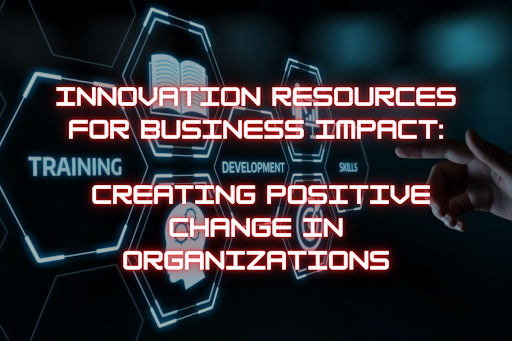Innovation is a crucial driver of business success. This enables organizations to stay competitive, grow, and achieve their goals. But achieving innovation is not always easy. Organizations need to invest in resources that help them drive innovation and create positive change.
In this article, we will explore some of the best innovation resources that organizations can use to drive business impact and create a culture of innovation. We will discuss its importance in creating positive change in organizations. By the end of this article, you will have a better understanding of the value of innovation resources and the different options available to help your organization drive innovation and achieve its goals.

Innovation Labs
Innovation labs are physical spaces that are dedicated to experimentation, collaboration, and innovation. These spaces are equipped with cutting-edge technology, tools, and resources. These enable organizations to explore new ideas, test prototypes, and develop innovative products and services. They are designed to foster a culture of innovation and creativity. This can provide employees with the freedom to experiment and take risks in a supportive environment.
- One of the key benefits of investing in innovation labs is the ability to accelerate product development. By providing teams with access to specialized equipment, resources, and expertise, organizations can streamline the development process and bring new products and services to market faster.
Additionally, innovation labs can help organizations stay ahead of the curve. It can give them the ability to explore emerging technologies and trends in a controlled environment.
- Another benefit of innovation labs is their ability to foster collaboration and teamwork. By bringing together employees from different departments and disciplines, it can break down silos and encourage cross-functional collaboration. This can lead to the development of more innovative and creative ideas. This will increase engagement and job satisfaction among employees.
Some successful examples of innovation labs include Google X, General Electric’s Global Research Center, and NASA’s Jet Propulsion Laboratory. These organizations have used it to develop cutting-edge technologies, products, and services that have had a significant impact on their industries.
These are powerful innovation resources for organizations, especially for those who want to drive innovation and create positive change. By providing teams with access to specialized resources and creating a supportive environment for experimentation and collaboration, innovation labs can accelerate product development. They can foster creativity and help organizations stay ahead of the curve.
Innovation Challenges
Innovation challenges involve inviting employees or external participants to develop solutions to a specific problem or challenge facing the organization. These challenges can take many forms, such as hackathons, design sprints, or ideation sessions.
- One of the main benefits of innovation challenges is their ability to generate new ideas and perspectives. By opening up the challenge to a diverse range of participants, organizations can tap into a wider pool of knowledge and expertise. This leads to the development of more creative and innovative solutions.
Additionally, it can help organizations identify new talent and potential partners. As well as boost employee engagement and morale.
- Another benefit of innovation challenges is the ability to rapidly prototype and test new ideas. With a clear problem or challenge to solve, participants can work quickly and collaboratively. They can develop potential solutions, test them, and refine them based on feedback. This can lead to the development of new products, services, or processes that are more effective and efficient than existing solutions.
Examples of successful innovation challenges include the XPRIZE. They challenge participants to solve some of the world’s biggest problems. Another is the Verizon 5G Challenge, which invites participants to develop new solutions using 5G technology. These challenges have resulted in the development of innovative solutions that have had a significant impact on their respective industries.
Innovation challenges are a valuable resource for organizations that want to drive innovation and create positive change. By inviting participants to develop solutions to specific challenges, organizations can tap into a wider range of knowledge and expertise, rapidly prototype and test new ideas, and boost employee engagement and morale.
Innovation Training and Development
Innovation training and development is an essential resource for organizations, especially for those who want to foster a culture of innovation and creativity. These programs aim to equip employees with the skills and knowledge they need to drive innovation and bring new ideas to the table. Training and development for innovation can take many forms. This includes workshops, seminars, or online courses.
- One of the key benefits of innovation training and development is its ability to create a common language around innovation. By providing employees with a shared understanding of innovation processes and methods, organizations can foster a culture of collaboration and shared goals.
Additionally, innovation training and development can help employees develop critical thinking and problem-solving skills. As well as the ability to adapt to change and uncertainty.
- Another benefit of innovation training and development is the ability to stay up-to-date with emerging trends and technologies. As the business landscape continues to evolve, organizations must be able to adapt and innovate to stay competitive.
Innovation training and development programs can help employees stay ahead of the curve. It can provide them with the latest knowledge and tools needed to succeed in a changing environment.
Examples of successful innovation training and development programs include Stanford D.School’s “Design Thinking Bootcamp” and Google’s “Sprint Master Academy.” These programs have helped employees develop critical innovation skills and apply them to real-world business challenges.
If your organization is looking to invest in innovation, consider implementing an innovation training and development program. This can unlock your team’s full potential.
Innovation Partnerships
These partnerships involve collaborating with external organizations or individuals. Its goal is to share knowledge, expertise, and resources in pursuit of a common goal. Innovation partnerships can take many forms. This includes joint ventures, research collaborations, or open innovation initiatives.
- One of the main benefits of innovation partnerships is the ability to access new knowledge and expertise. By collaborating with external partners, organizations can tap into a wider pool of skills and knowledge. This can lead to the development of more innovative and effective solutions.
Additionally, innovation partnerships can help organizations expand their reach and access new markets. As well as reduce costs by sharing resources and risks.
- Another benefit of innovation partnerships is the ability to leverage complementary strengths and capabilities. By partnering with organizations that have different strengths and expertise, organizations can create a more well-rounded team and achieve a higher level of innovation.
For example, a technology company may partner with a design firm to create a more user-friendly product. Another one is a healthcare company, they may partner with a data analytics firm to develop more effective treatments.
Successful examples of innovation partnerships include Apple’s partnership with Nike to develop the Nike+ running app. Ford’s partnership with Microsoft to develop the Sync infotainment system is another example. These partnerships have resulted in the development of innovative products and services that have had a significant impact on their respective industries.
By collaborating with external partners, organizations can access new knowledge and expertise, expand their reach, and leverage complementary strengths and capabilities. If your organization is looking to drive innovation, consider forming an innovation partnership to unlock new opportunities and achieve your goals.
Conclusion
In conclusion, innovation resources are essential for organizations that want to thrive in today’s rapidly changing business environment. Innovation labs provide a space for experimentation and idea generation, while innovation challenges encourage creative problem-solving and collaboration. Innovation training and development programs can help employees develop the skills and mindset needed to drive innovation, and innovation partnerships can unlock new opportunities for growth and expansion.
By embracing a culture of innovation and investing in these resources, organizations can differentiate themselves from competitors, stay up-to-date with emerging trends and technologies, and create new products and services that meet the needs of customers. Ultimately, organizations that prioritize innovation are more likely to achieve long-term success and remain relevant in an increasingly competitive market.
FAQs
Why Are Innovation Resources Important for Businesses?
Innovation resources are important for businesses because they can help organizations stay competitive, adapt to changing business landscapes, and unlock new opportunities for growth and expansion.
How Can Organizations Measure the Impact of Their Innovation Efforts?
Organizations can measure the impact of their innovation efforts through metrics. This includes revenue growth, customer satisfaction, and employee engagement. As well as through qualitative assessments such as feedback and testimonials from stakeholders.
What Are Some Common Challenges Organizations Face When Trying to Drive Innovation?
Common challenges organizations face when trying to drive innovation include resistance to change, a lack of resources or budget, risk aversion, and difficulty measuring and demonstrating the value of innovation efforts.




